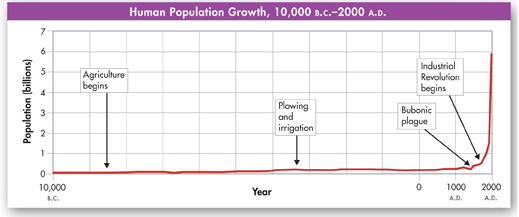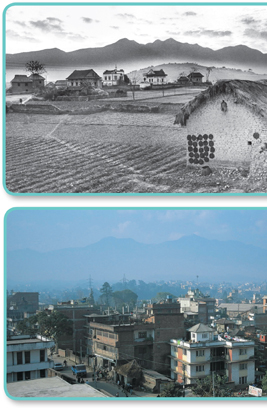
FIGURE 5–11 Human Population Growth Over Time After a slow start, the human population grew exponentially following advances in civilization. Change can be dramatic; these photos of Katmandu, Nepal, were taken from the same position in 1969 and 1999—just 30 years apart!
d
World Population Growth Slows So what is happening to human population growth today? Exponential growth continued up to the second half of the twentieth century. The human population growth rate reached a peak around 1962–1963, and then it began to drop. The size of the global human population is still growing rapidly, but the rate of growth is slowing down.
It took 123 years for the human population to double from 1 billion in 1804 to 2 billion in 1927. Then it took just 33 years for it to grow by another billion people. The time it took for the population to increase each additional billion continued to fall until 1999, when it began, very slowly, to rise. It now takes longer for the global human population to grow by 1 billion than it did 20 years ago. What has been going on?
Patterns of Human Population Growth
 Why do population growth rates differ among countries?
Why do population growth rates differ among countries?
Scientists have identified several social and economic factors that affect human population growth. The scientific study of human populations is called demography. Demography examines characteristics of human populations and attempts to explain how those populations will change over time.  Birthrates, death rates, and the age structure of a population help predict why some countries have high growth rates while other countries grow more slowly.
Birthrates, death rates, and the age structure of a population help predict why some countries have high growth rates while other countries grow more slowly.
 In Your Notebook Explain how the size of the global human population can increase while the rate of growth decreases.
In Your Notebook Explain how the size of the global human population can increase while the rate of growth decreases.
Table of Contents
- Formulas and Equations
- Applying Formulas and Equations
- Mean, Median, and Mode
- Estimation
- Using Measurements in Calculations
- Effects of Measurement Errors
- Accuracy
- Precision
- Comparing Accuracy and Precision
- Significant Figures
- Calculating With Significant Figures
- Scientific Notation
- Calculating With Scientific Notation
- Dimensional Analysis
- Applying Dimensional Analysis




